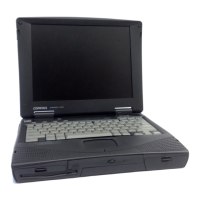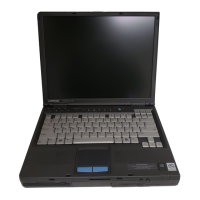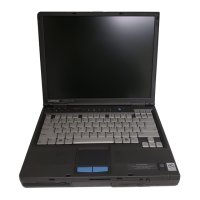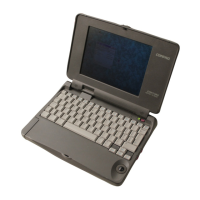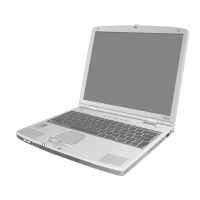Preparing the Computer
>>>>>>>>>>>>>>>>>>>>>>>>>>>>>>>>> WARNING <<<<<<<<<<<<<<<<<<<<<<<<<<<<<<<<<
Ensure that the power cord is disconnected from the electrical outlet and
that the battery pack is removed from the computer before beginning
replacement procedures. Failure to disconnect power could result in serious
injury or damage to the equipment.
>>>>>>>>>>>>>>>>>>>>>>>>>>>>>>>>>>>>><<<<<<<<<<<<<<<<<<<<<<<<<<<<<<<<<<<<<<
>>>>>>>>>>>>>>>>>>>>>>>>>>>>>>>>> CAUTION <<<<<<<<<<<<<<<<<<<<<<<<<<<<<<<<<
Static electricity can damage electronic components. Before beginning these
procedures, make sure you are grounded (discharged of static electricity)
by briefly touching a grounded, unpainted, metal object or surface.
>>>>>>>>>>>>>>>>>>>>>>>>>>>>>>>>>>>>><<<<<<<<<<<<<<<<<<<<<<<<<<<<<<<<<<<<<<
Before beginning the removal and replacement procedures, follow these steps
to disconnect all power to the computer and remove the diskette or PC
(PCMCIA) Card, if installed:
1. Save all files and exit all applications.
2. Turn off the computer. To turn off the computer when in Windows
applications, click Shut Down from the Start menu. When the
power/standby indicator light goes off, the computer has been
successfully shut down. In case of a severe system lock- up, when the
mouse doesn't work and Ctrl+Alt+Del is not recognized by the unit,
press Ctrl+Alt + the power button to shut down the unit. This method
can also be used if you are in DOS mode (an option chosen from the Shut
Down menu). In this instance, Shut Down is not available because
Windows isn't running.
3. Disconnect all external equipment.
4. Disconnect the AC Adapter from the electrical outlet (Figure 5-2).

